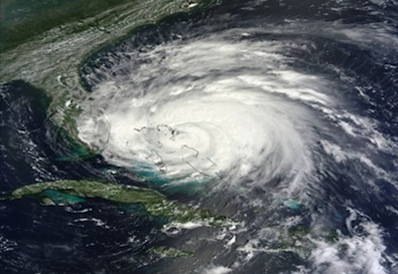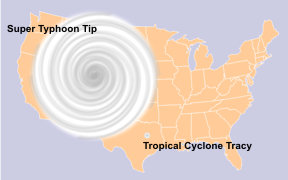Hurricane Irene was huge! But are the big storms more harmful? You might be surprised to find the answer.
Experts described the storm as Category 3 with winds reaching 120 mph (195 kph if you speak metric) and atmospheric pressure of 942 mbar (really intense).
However, the first impression Irene makes when you looked at its pictures is—Yikes! It’s big!
Satellite pictures show that it reached from Cuba to the Carolinas. When the space station in orbit was taking pictures, it took six minutes to cross it. It was over 600 miles wide, a diameter one-third the length of the entire U.S. eastern seaboard.

Irene stretched from Cuba to the Carolinas! SOURCE: NASA
It was giant, but records show that it was not even half as large as the largest hurricane. The biggest tropical storm was Super Typhoon Tip, which had a diameter of 1,380, which is half as large as the continental United States. That storm, the largest and most intense on record, slammed Japan in October 1979. It wrecked a lot of ships, killed a lot of people and, oddly enough, set fire to a US Marine base.
Yet when we concentrate on the giants, don’t ignore the little guys. Hurricanes can be huge, but they also can be quite small. Indeed, one cyclone, Tropical Storm Marco in 2008, was only 11.5 miles across! It was born in Central America, trekked across the Yucatan Peninsula, swirled in the Gulf of Mexico and finally crashed into Mexico near Veracruz. It was too tiny to do much damage, but the little beast caused 10 foot high floods.
Hurricanes come in all sizes. SOURCE: NOAA
 Small doesn’t mean harmless however. Before Marco, the smallest known tropical storm was Cyclone Tracy. She was only 30 miles across but had the intensity of a Category 3 hurricane. She hit Darwin, Australia, on Christmas Eve, 1974. The little Grinch wrecked 70% of the cities buildings, leaving 41,000 people homeless. Newspapers called the tiny hurricane “a disaster of the first magnitude … without parallel in Australia’s history.”
Small doesn’t mean harmless however. Before Marco, the smallest known tropical storm was Cyclone Tracy. She was only 30 miles across but had the intensity of a Category 3 hurricane. She hit Darwin, Australia, on Christmas Eve, 1974. The little Grinch wrecked 70% of the cities buildings, leaving 41,000 people homeless. Newspapers called the tiny hurricane “a disaster of the first magnitude … without parallel in Australia’s history.”
In short, size doesn’t really matter. Like real estate, the key to hurricanes is location, location, location. If the world’s largest hurricane wanders through the ocean waters, all it is going to do is scare ships and churn up fish. If a tiny storm visits a city—look out!



 Small doesn’t mean harmless however. Before Marco, the smallest known tropical storm was Cyclone Tracy. She was only 30 miles across but had the intensity of a Category 3 hurricane. She hit Darwin, Australia, on Christmas Eve, 1974. The little Grinch wrecked 70% of the cities buildings, leaving 41,000 people homeless. Newspapers called the tiny hurricane “a disaster of the first magnitude … without parallel in Australia’s history.”
Small doesn’t mean harmless however. Before Marco, the smallest known tropical storm was Cyclone Tracy. She was only 30 miles across but had the intensity of a Category 3 hurricane. She hit Darwin, Australia, on Christmas Eve, 1974. The little Grinch wrecked 70% of the cities buildings, leaving 41,000 people homeless. Newspapers called the tiny hurricane “a disaster of the first magnitude … without parallel in Australia’s history.”







Comments